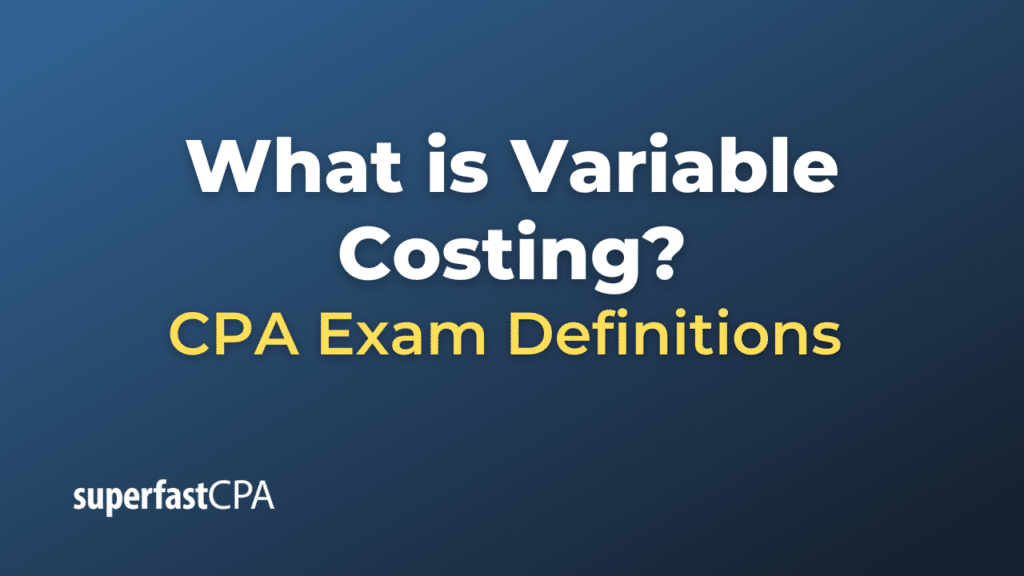Variable Costing
Variable costing, also known as direct costing or marginal costing, is a costing method where only the variable costs of production are allocated to the manufactured goods. Fixed costs, such as rent, administrative salaries, and other overhead expenses, are treated as period expenses and are not included in the cost of individual products. In other words, fixed costs are expensed in the period in which they are incurred and are not tied to individual units of output.
Components:
In variable costing, the cost of a product or service includes:
Fixed costs are treated separately and are accounted for in the income statement as a whole, rather than being allocated to individual units.
Formula:
In variable costing, the cost of goods sold and ending inventory are calculated based on variable production costs. The formula for cost per unit under variable costing is:
Cost Per Unit (Variable Costing) = Direct Material Cost Per Unit + Direct Labor Cost Per Unit + Variable Overhead Cost Per Unit
Advantages:
- Simplicity: Variable costing is simpler to understand and apply, especially in short-term decision-making.
- Contribution Margin: This method highlights the contribution margin, which is the revenue remaining per unit after covering variable costs, useful for break-even analysis.
- Performance Evaluation: Variable costing can be beneficial for internal performance evaluations as it does not allocate fixed costs to products, making it easier to analyze the profitability of individual items.
- Short-Term Pricing Decisions: It can be more useful for setting prices in specific scenarios, especially for special orders or in a competitive pricing environment.
Disadvantages:
- Long-Term Viability: Variable costing can be misleading over the long term since it does not account for fixed costs that must be covered to ensure the business is profitable in the long run.
- Inventory Valuation: It tends to understate the value of ending inventory because it includes only variable costs.
- Non-GAAP: Variable costing is not accepted by Generally Accepted Accounting Principles (GAAP) for external financial reporting.
Example of Variable Costing
Let’s go through an example to illustrate the concept of variable costing in a business setting.
Business Context:
Let’s consider a fictional company called “GadgetPro,” which manufactures wireless earbuds.
Costs and Production:
GadgetPro has the following cost structure for manufacturing one pair of wireless earbuds:
- Direct Material: $15
- Direct Labor: $10
- Variable Overhead: $5
The company also incurs a fixed cost of $20,000 per month for rent, administrative salaries, and other overheads that do not vary with production.
Units Produced and Sold:
For simplicity, let’s say GadgetPro produced 2,000 units and sold 1,800 units in the month of March.
Variable Costing Calculation:
Under variable costing, the cost per unit would include only the variable costs:
Cost Per Unit (Variable Costing) = DirectMaterial + DirectLabor + VariableOverhead
= $15 + $10 + $5
= $30
Income Statement:
Here’s how GadgetPro’s income statement would look like under variable costing for March:
Revenues:
- Selling Price per Unit: $60
- Total Revenue (1,800 units sold * $60): $108,000
Cost of Goods Sold (COGS):
- Cost per unit: $30
- COGS (1,800 units sold * $30): $54,000
- Gross Margin (Total Revenue – COGS): $54,000
Fixed Costs:
- Rent, administrative salaries, etc.: $20,000
- Net Income (Gross Margin – Fixed Costs): $34,000
Business Implications:
- The contribution margin per unit is $30 ($60 Selling Price – $30 Variable Cost).
- The fixed costs of $20,000 are treated as period costs and are not allocated to individual units. Therefore, the inventory valuation is lower under variable costing compared to absorption costing, which would include fixed overhead in the inventory.
- The net income reflects the profit after covering both variable and fixed costs. Management can use this information to make decisions about production levels, pricing strategies, and cost control measures.
By understanding variable costing, GadgetPro can make better-informed decisions that align with its financial goals, especially for short-term scenarios.












